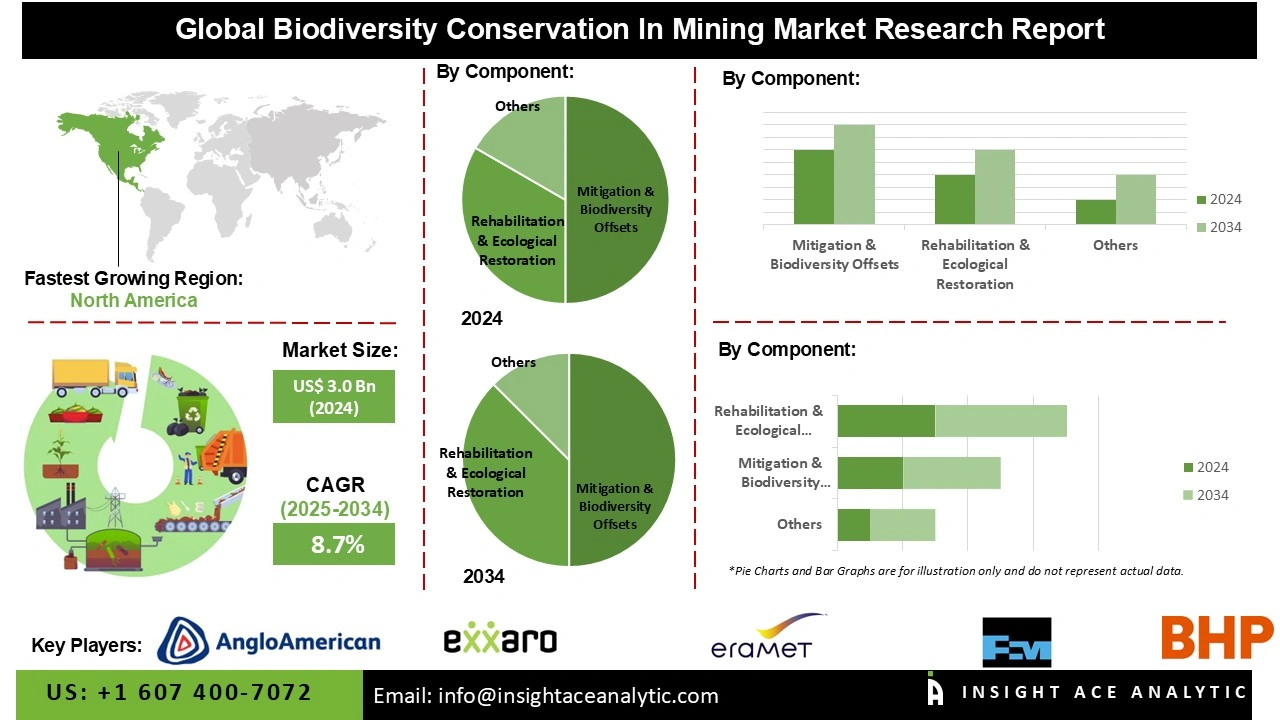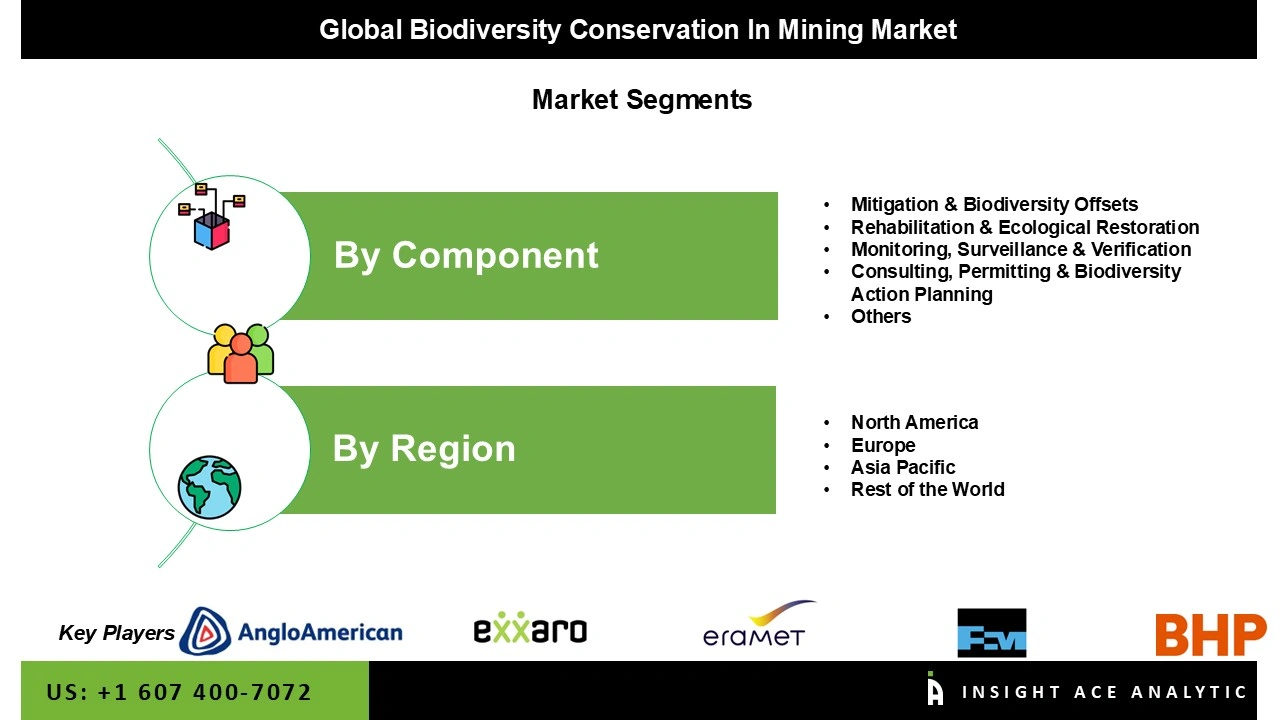Biodiversity Conservation In Mining Market is valued at US$ 3.0 Bn in 2024 and it is expected to reach US$ 6.78 Bn by 2034, with a CAGR of 8.7% during the forecast period of 2025-2034.

Biodiversity conservation in mining comprises the systematic approaches and measures used to protect, restore, and sustainably manage ecosystems and species in mining-affected areas. This involves minimizing ecological disruption through careful site planning, environmental impact assessments, and low-impact extraction methods. During operations, companies implement measures such as soil and water management, wildlife protection programs, and continuous ecological monitoring. Post-mining rehabilitation focuses on restoring native habitats, replanting indigenous vegetation, and supporting long-term ecosystem recovery.
The expansion of biodiversity conservation in mining is driven by regulatory requirements, corporate responsibility initiatives, and stakeholder expectations. Governments & international bodies are implementing stricter environmental regulations that mandate conservation outcomes, while growing ESG investment criteria create strong incentives for demonstrated ecological stewardship. These factors are generating increased demand for specialized conservation services, including ecological consulting, digital monitoring solutions, and habitat restoration expertise. Technological advancements in remote sensing, GIS mapping, and data analytics further support this growth by enabling more precise impact assessment and effective long-term ecosystem management.
Some of the Key Players in Biodiversity Conservation In the Mining Market:
The biodiversity conservation in mining market is segmented by component. By component, the market is segmented into rehabilitation & ecological restoration, mitigation & biodiversity offsets, consulting, permitting & biodiversity action planning, monitoring, surveillance & verification, and others.
In 2024, the mitigation & biodiversity offsets category dominated the biodiversity conservation in the mining market. The continuously increasing implementation of environmental regulations and the worldwide transition to sustainable mining techniques are driving the segment's growth. In order to balance ecological losses, offset programs have become widely used as a result of governments and financial institutions requiring mining operations to show quantifiable biodiversity impacts. Additionally, "no-net-loss" or "net-positive" biodiversity goals are emphasized by regulatory laws in places like australia, canada, and south africa, which encourage miners to repair damaged ecosystems or save comparable areas elsewhere.
In 2024, the asia pacific region maintained its dominant position in the biodiversity conservation market for mining, driven by expanding mining operations across developing economies and heightened recognition of ecological impacts in environmentally sensitive zones. Governments across australia, india, and southeast asian nations are implementing stricter environmental impact assessment requirements and mandating comprehensive rehabilitation obligations, compelling mining companies to adopt systematic conservation approaches. The region's significant biological diversity and extensive protected areas further amplify the importance of responsible mining practices, stimulating demand for habitat restoration initiatives, biodiversity offset programs, and community-led conservation projects.
Europe is estimated to report the highest growth rate in biodiversity conservation in the mining market during the forecast period. This accelerated expansion is fueled by the European Union's rigorous environmental regulatory framework, which enforces stringent standards for ecological impact assessment, habitat restoration, and long-term ecosystem management. The region's growth is further supported by strong advocacy from environmental organizations and indigenous communities, alongside the rapid integration of advanced conservation technologies. These include automated biodiversity monitoring systems, GIS-based habitat mapping, and remote sensing applications, which are becoming standard tools for demonstrating compliance and achieving conservation excellence in mining operations.
|
Report Attribute |
Specifications |
|
Market Size Value In 2024 |
USD 3.0 Bn |
|
Revenue Forecast In 2034 |
USD 6.78 Bn |
|
Growth Rate CAGR |
CAGR of 8.7% from 2025 to 2034 |
|
Quantitative Units |
Representation of revenue in US$ Bn and CAGR from 2025 to 2034 |
|
Historic Year |
2021 to 2024 |
|
Forecast Year |
2025-2034 |
|
Report Coverage |
The forecast of revenue, the position of the company, the competitive market structure, growth prospects, and trends |
|
Segments Covered |
By Component and By Region |
|
Regional Scope |
North America; Europe; Asia Pacific; Latin America; Middle East & Africa |
|
Country Scope |
U.S.; Canada; Germany; The UK; France; Italy; Spain; Rest of Europe; China; Japan; India; South Korea; Southeast Asia; Rest of Asia Pacific; Brazil; Argentina; Mexico; Rest of Latin America; GCC Countries; South Africa; Rest of the Middle East and Africa |
|
Competitive Landscape |
Hindustan Zinc Ltd., Imerys, Anglo American plc, BHP Group, Freeport-McMoRan, Glencore plc, Rio Tinto Group, Eramet Group, Exxaro Resources Limited, and Vale S.A. |
|
Customization Scope |
Free customization report with the procurement of the report, Modifications to the regional and segment scope. Geographic competitive landscape. |
|
Pricing and Available Payment Methods |
Explore pricing alternatives that are customized to your particular study requirements. |
Chapter 1. Methodology and Scope
1.1. Research Methodology
1.2. Research Scope & Assumptions
Chapter 2. Executive Summary
Chapter 3. Global Biodiversity Conservation In Mining Market Snapshot
Chapter 4. Global Biodiversity Conservation In Mining Market Variables, Trends & Scope
4.1. Market Segmentation & Scope
4.2. Drivers
4.3. Challenges
4.4. Trends
4.5. Investment and Funding Analysis
4.6. Porter's Five Forces Analysis
4.7. Incremental Opportunity Analysis (US$ MN), 2025-2034
4.8. Global Biodiversity Conservation In Mining Market Penetration & Growth Prospect Mapping (US$ Mn), 2024-2034
4.9. Competitive Landscape & Market Share Analysis, By Key Player (2024)
4.10. Use/impact of AI on Biodiversity Conservation In Mining Market Industry Trends
Chapter 5. Biodiversity Conservation In Mining Market Segmentation 1: By Component, Estimates & Trend Analysis
5.1. Market Share by Component, 2024 & 2034
5.2. Market Size (Value (US$ Mn) & Forecasts and Trend Analyses, 2021 to 2034 for the following Component:
5.2.1. Mitigation & Biodiversity Offsets
5.2.2. Rehabilitation & Ecological Restoration
5.2.3. Monitoring, Surveillance & Verification
5.2.4. Consulting, Permitting & Biodiversity Action Planning
5.2.5. Others
Chapter 6. Biodiversity Conservation In Mining Market Segmentation 2: Regional Estimates & Trend Analysis
6.1. Global Biodiversity Conservation In Mining Market, Regional Snapshot
2024 & 2034
6.2. North America
6.2.1. North America Biodiversity Conservation In Mining Market Revenue (US$ Mn) Estimates and Forecasts by Country, 2021-2034
6.2.1.1. US
6.2.1.2. Canada
6.2.2. North America Biodiversity Conservation In Mining Market Revenue (US$ Mn) Estimates and Forecasts by Component, 2021-2034
6.3. Europe
6.3.1. Europe Biodiversity Conservation In Mining Market Revenue (US$ Mn) Estimates and Forecasts by Country, 2021-2034
6.3.1.1. Germany
6.3.1.2. U.K.
6.3.1.3. France
6.3.1.4. Italy
6.3.1.5. Spain
6.3.1.6. Rest of Europe
6.3.2. Europe Biodiversity Conservation In Mining Market Revenue (US$ Mn) Estimates and Forecasts by Component, 2021-2034
6.4. Asia Pacific
6.4.1. Asia Pacific Biodiversity Conservation In Mining Market Revenue (US$ Mn) Estimates and Forecasts by Country, 2021-2034
6.4.1.1. India
6.4.1.2. China
6.4.1.3. Japan
6.4.1.4. Australia
6.4.1.5. South Korea
6.4.1.6. Hong Kong
6.4.1.7. Southeast Asia
6.4.1.8. Rest of Asia Pacific
6.4.2. Asia Pacific Biodiversity Conservation In Mining Market Revenue (US$ Mn) Estimates and Forecasts by Component, 2021-2034
6.5. Latin America
6.5.1. Latin America Biodiversity Conservation In Mining Market Revenue (US$ Mn) Estimates and Forecasts by Country, 2021-2034
6.5.1.1. Brazil
6.5.1.2. Mexico
6.5.1.3. Rest of Latin America
6.5.2. Latin America Biodiversity Conservation In Mining Market Revenue (US$ Mn) Estimates and Forecasts by Component, 2021-2034
6.6. Middle East & Africa
6.6.1. Middle East & Africa Biodiversity Conservation In Mining Market Revenue (US$ Mn) Estimates and Forecasts by country, 2021-2034
6.6.1.1. GCC Countries
6.6.1.2. Israel
6.6.1.3. South Africa
6.6.1.4. Rest of Middle East and Africa
6.6.2. Middle East & Africa Biodiversity Conservation In Mining Market Revenue (US$ Mn) Estimates and Forecasts by Component, 2021-2034
Chapter 7. Competitive Landscape
7.1. Major Mergers and Acquisitions/Strategic Alliances
7.2. Company Profiles
7.2.1. Anglo American plc
7.2.1.1. Business Overview
7.2.1.2. Key End Use/Service
7.2.1.3. Financial Performance
7.2.1.4. Geographical Presence
7.2.1.5. Recent Developments with Business Strategy
7.2.2. BHP Group
7.2.3. Eramet Group
7.2.4. Exxaro Resources Limited
7.2.5. Freeport-McMoRan
7.2.6. Glencore plc
7.2.7. Hindustan Zinc Ltd.
7.2.8. Imerys
7.2.9. Rio Tinto Group
7.2.10. Vale S.A.
Biodiversity Conservation In Mining Market by Component-
· Rehabilitation & Ecological Restoration
· Mitigation & Biodiversity Offsets
· Consulting, Permitting & Biodiversity Action Planning
· Monitoring, Surveillance & Verification
· Others

Biodiversity Conservation In Mining Market by Region-
North America-
· The US
· Canada
Europe-
· Germany
· The UK
· France
· Italy
· Spain
· Rest of Europe
Asia-Pacific-
· China
· Japan
· India
· South Korea
· Southeast Asia
· Rest of Asia Pacific
Latin America-
· Brazil
· Argentina
· Mexico
· Rest of Latin America
Middle East & Africa-
· GCC Countries
· South Africa
· Rest of the Middle East and Africa
InsightAce Analytic follows a standard and comprehensive market research methodology focused on offering the most accurate and precise market insights. The methods followed for all our market research studies include three significant steps – primary research, secondary research, and data modeling and analysis - to derive the current market size and forecast it over the forecast period. In this study, these three steps were used iteratively to generate valid data points (minimum deviation), which were cross-validated through multiple approaches mentioned below in the data modeling section.
Through secondary research methods, information on the market under study, its peer, and the parent market was collected. This information was then entered into data models. The resulted data points and insights were then validated by primary participants.
Based on additional insights from these primary participants, more directional efforts were put into doing secondary research and optimize data models. This process was repeated till all data models used in the study produced similar results (with minimum deviation). This way, this iterative process was able to generate the most accurate market numbers and qualitative insights.

Secondary research
The secondary research sources that are typically mentioned to include, but are not limited to:
The paid sources for secondary research like Factiva, OneSource, Hoovers, and Statista
Primary Research:
Primary research involves telephonic interviews, e-mail interactions, as well as face-to-face interviews for each market, category, segment, and subsegment across geographies
The contributors who typically take part in such a course include, but are not limited to:
Data Modeling and Analysis:
In the iterative process (mentioned above), data models received inputs from primary as well as secondary sources. But analysts working on these models were the key. They used their extensive knowledge and experience about industry and topic to make changes and fine-tuning these models as per the product/service under study.
The standard data models used while studying this market were the top-down and bottom-up approaches and the company shares analysis model. However, other methods were also used along with these – which were specific to the industry and product/service under study.
To know more about the research methodology used for this study, kindly contact us/click here